Two-minute review
Realme 8 series smartphones are said to take on the Redmi Note 10 series in India and the vanilla Realme 8 device falls in between the Redmi Note 10 and Redmi Note 10 Pro. The Realme 8 is a worthy rival to the Redmi Note 10 that recently came to India, with a similar formula of big specs at a competitive price.
The Realme 8 is the successor to the Realme 7 from September 2020. With just a six-month refresh cycle, Realme hasn’t brought any drastic changes with the Realme 8, but the company has provided what users have asked for in the past. While it does bring some new features to compete against Xiaomi, it also missed out on a couple of opportunities.
For starters, the first big change is the super AMOLED display on the Realme 8, an upgrade from the LCD panel on the Realme 7. While trying to incorporate the super AMOLED display, the company has omitted a high refresh rate display. Another nifty addition is the in-display fingerprint scanner - which is a first in the segment.
As for the performance the Realme 8 has retained the Helio G95 SoC from the last generation and has been optimized well enough to manage even the heaviest tasks. Realme UI 2.0 also makes its debut in India with the Realme 8 series by bringing in a plethora of customization options.

With a sleek profile of 7.99mm, the Realme 8 packs in a massive 5,000mAh battery which can easily last a day and a half with heavy usage and charging up the device can be done in an hour thanks to the 30W fast charger provided in the box.
In terms of camera, the primary camera on the back with 64MP is the only one that's worth your attention, along with selfies that come out good enough for social media shares. The camera department is the one area where the Realme 8 falls short of the competition.
At the end of the day, the Realme 8 is a good phone on its own, but when we start comparing it to the Redmi Note 10 Pro, the device falls beyond. But, Realme 8 does provide a better real-life experience than the Redmi Note 10 series and the availability is also not an issue with the device.
Realme 8 price in India and availability
Launched on March 24 in India, the Realme 8 is priced at Rs 14,999 for the 4GB RAM variant, the 6GB variant is priced at Rs 15,999 and the Rs 16,999 for the 8GB variant - all three variants come with 128GB internal storage. The Realme 8 is available in Cyber Silver and Cyber Black colour options. Flipkart is the official sale partner and the phone is available on open sale.
Realme 8 vs Realme 7
| Realme 8 | Realme 7 | |
|---|---|---|
| Display | 6.4" FHD+ AMOLED, 60Hz | 6.4" FHD+ LCD, 90Hz |
| Processor | MediaTek Helio G95 | MediaTek Helio G95 |
| RAM | 4/6/8GB LPDDR4X | 6/8GB LPDDR4X |
| Storage | 128GB UFS 2.1 | 64/128GB UFS 2.1 |
| Rear cameras | 64+8+2+2MP (Sony) | 64+8+2+2MP (Samsung) |
| Front camera | 16MP | 16MP |
| Battery | 5000mAh, 30W | 5000mAh, 30W |
| Weight | 177g | 196.5g |
| Thickness | 7.99mm | 9.4mm |
Design


Realme 8 has taken a different approach in terms of design as compared to the Realme 7. The phone now weighs 20 grams lighter (177 grams) and 1.5mm thinner (7.99mm) than its predecessor. It comes with a split design that divides the phone’s back vertically in an asymmetrical manner. The phone comes in two colour options - Cyber Silver and Cyber Black. We are using Cyber Black in this review.
The split design is divided between 70% and 30% on the back, the latter part houses the quad-camera setup on the rear inside a square module which juts out of the body and the former portion brings the big and bold Dare to leap branding - which is a pretty subjective thing to write about. I liked it on the Realme X7 Pro and here, the branding is pretty subtle on the Black variant, so it is not as eye-catchy as on the Realme X7 Pro or the Cyber Silver colour of the Realme 8.






The back panel is made up of polycarbonate material with a mix of glossy and matte finish on the back. The Realme 8 has a metal frame running over the body with volume rockers and power located on the right side while the bottom houses a Type-C port, speaker, and 3.5mm headphone jack.
To the front, there is a 6.4-inch super AMOLED display with a pre-installed screen protector of really bad quality. There is a single punch-hole selfie camera cut-out and also, the speaker grill is flushed just above the display. One thing that we couldn’t stop but notice is the very thick bezel on the bottom of the phone which is weird for a phone with an AMOLED display in 2021.
The device is very handy and comfortable to use - kudos to Realme for making it sleek and also packing in a massive battery. The back panel also attracted fingerprints easily and it was very hard to keep it clean and taking pictures was an extreme task in itself, thankfully Realme is offering a transparent case in the box.
Display

The Realme 8 retains the same-sized 6.4-inch screen as that of the Realme 7, but now you get a Super AMOLED panel. It is a Full HD+ resolution display with a 90.8% screen-to-body ratio and a peak brightness of 1,00 nits. However, it misses out on a high refresh rate. We feel Realme missed an opportunity by not providing it, especially when the phone will be taking on the Redmi Note 10 Pro series.
Leaving behind the high refresh rate, the display itself is an excellent one that produces great colours, contrast, and vivid colours. The out of the box colour itself was balanced well and you can always go ahead and change to warmer or cooler tones if needed under the display settings. You also get the OSIE visual effect which brings more colour and brightness to life. The blacks are pitch dark and you will notice deep blacks once to start consuming content on the phone.
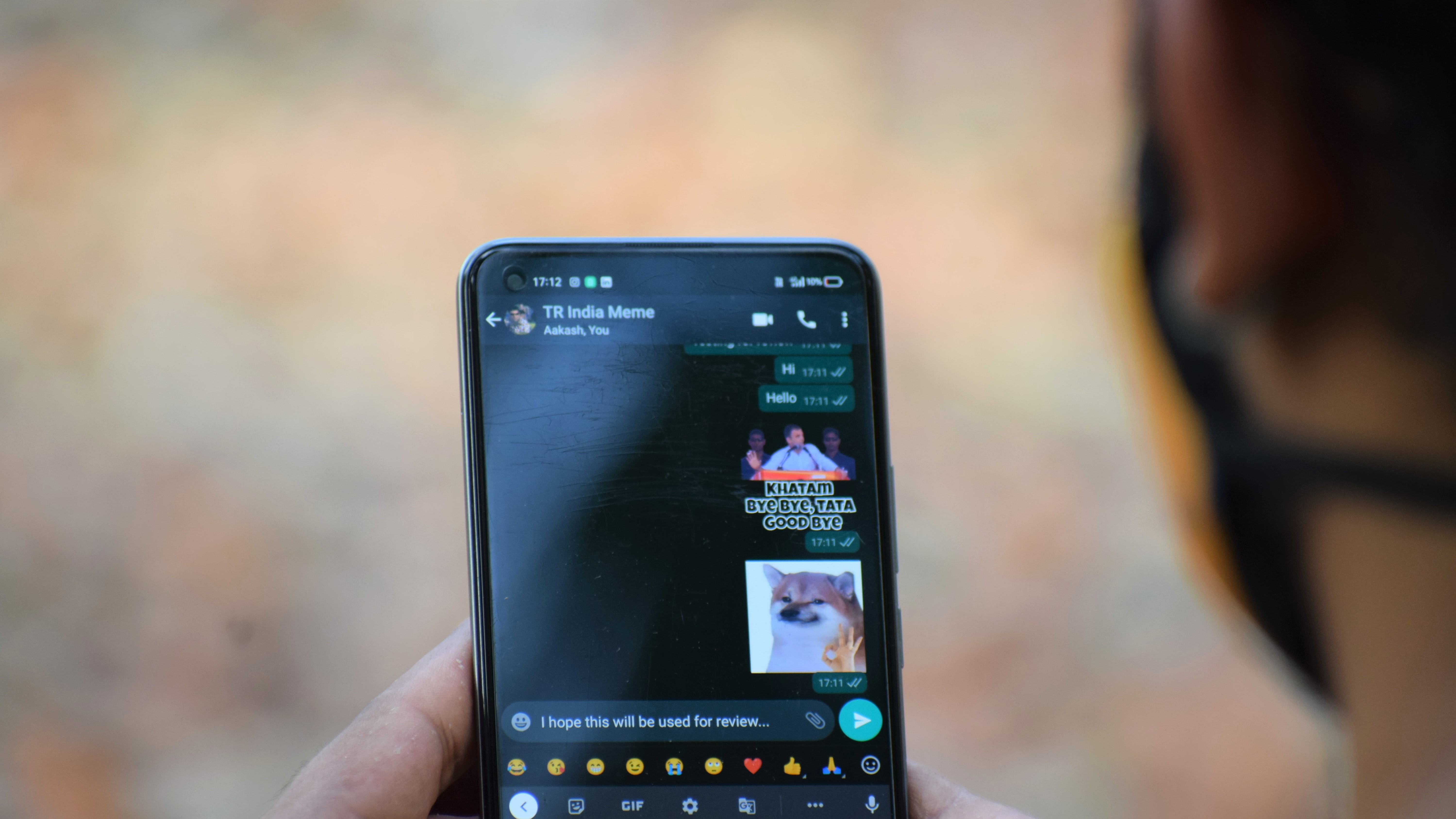

Further, there are also Always on Display options that can show you the date, time, and notification. Unlike the Redmi Note 10 series, the Always-on Display here stays on all the time. Also, the auto-brightness worked well and we had no issues as we had on the Realme 8 Pro. We also had no issues with brightness or the viewing angle on the device. With the 180Hz touch sampling rate, the handset is responsive to all the touches and swipes.
While the lack of a high refresh rate is hard to ignore here, Realme has nailed every other aspect of the display with a good quality super AMOLED panel.
Performance

The Realme 8 is powered by the same chipset as its predecessor, the MediaTek Helio G95 chipset. It is an eight-core processor with 2.05GHz clock speed and cooped with Arm Mali-G76 MC4 GPU. The chipset made its global debut on Realme 7 back in September 2020. The chipset is marketed as a gaming-centric SoC.
The Realme 8 comes in three configurations with 4/6/8GB LPDDR4X RAM and 128GB UFS 2.1 internal storage standard across three variants. 128GB internal storage should be more than enough for even the heaviest users. In case that’s not enough, the Realme 8 also comes with a dedicated microSD card slot that can support up to 256GB of additional storage.
While there is a lot of debate going on about the chipset used on the Realme 8 series, the day to day experience is what matters for any phone. And, we are happy to report that Realme 8’s performance was excellent during our testing time.
Using the same chipset gives a chance to the phone maker to optimize it well
As one can expect, the day to day and Social media apps like WhatsApp, Gmail, Instagram, Facebook, Snapchat, Slack, Camera apps ran pretty smoothly on the phone. The opening and closing of the apps are also as fast as ever. The RAM management has been great too - one area where the Redmi Note 10 Pro is struggling right now. Switching between apps and multitasking was also a breeze. Since there is no high refresh rate on board, the animations and transitions stay consistent throughout the usage.


Gaming was also fine when we tried out games like Asphalt 9, Call of Duty: Mobile, and Real Racing 3 with the highest possible graphics settings. We are happy to report that the gaming performance was enjoyable on the device. While playing CoD: Mobile game, we got a 45-60fps count even after 30 minutes of gameplay and the phone did get a bit warm but did not heat up.
Additionally, the Realme 8 also comes with a dedicated game space tool that allows getting control over notifications, brightness, game mode, and three performance modes - low power, balanced, and Pro gamer. There is also a smart dual-channel network (4G+Wi-Fi) to improve the gaming experience. You can also block all notifications and calls while playing the game. The tool can be bought up while gaming by swiping right on the screen from which. It also displays CPU and GPU utilization and also FPS.
The calls were loud and clear, but we had a bit of an issue with VoWiFi calls (Jio), we have reached out to Realme regarding this issue and we will update the piece when we get back the response. As for the speaker, it is a sole bottom-firing speaker which outputs average sound at best. There is also a 3.5mm headphone jack for those who prefer wired listening.
There is also support for dual-band Wi-Fi, Bluetooth 5.1, 4G VoLTE - all of them work as intended. Overall, the performance and gaming were pretty smooth and enjoyable on the Realme 8. As Realme’s Product Manager told us, the more they use the chipset on phones, the more control they get over and they can optimize it perfectly. And, that statement stands for itself with the Realme 8’s performance. We had a bit of performance jitter with Realme 7 and with Realme 8 that seems to be gone for good.
Software

The Realme 8 series is the first set of phones from the brand to run on Realme UI 2.0 based on Android 11 out of the box. The phone comes with some pre-installed apps such as Amazon, Browser, Community, DocVault, Game Space, HeyFun, HeyTap, Realme Store, Podcast, Realme Link, Snapchat, and more first-party apps - the default phone and SMS apps are from Google.
Two apps - HeyFun and Browser are the two apps that send push notifications frequently. While the former can be uninstalled, the latter cannot be uninstalled or disabled - we had to disable the notifications. Apart from these two apps, there are no other ads or spam notifications.
As for the Realme UI 2.0 features, the Android 11 based skin brings a ton of customizations. Under settings > Personalizations, you can customize Themes, Wallpapers, Icons, App layout, fingerprint style, colours, font size and display size, and notification drawer. The dark mode also makes its way and on the AMOLED display, it looks extremely good.

In terms of privacy and security, the phone offers privacy protection features which include app lock, hide apps, private safe where you can set a 6 pin password and save images, videos, docs, audio, and other files from others. There are also options for cloning the whole system and Kid space. A permission manager to take care of the app’s permissions and payment protection for apps like Phonepe, Google Pay are also present.
Realme’s nifty dual-mode audio, which allows you to connect both a wired and wireless earphone and stream media, is present under Realme Lab settings, along with DC Dimming, Smooth scrolling, and Sleep capsule options.
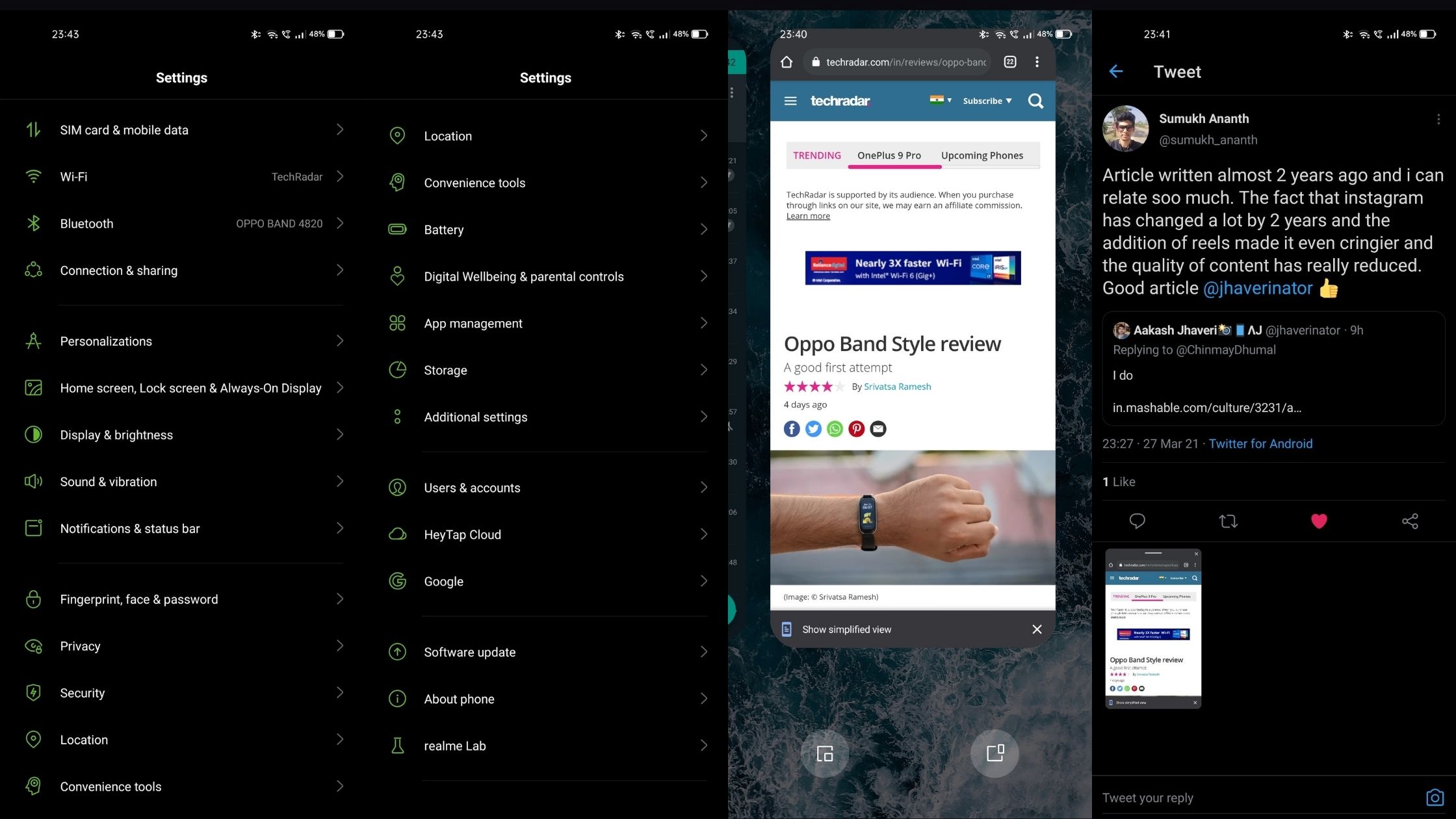
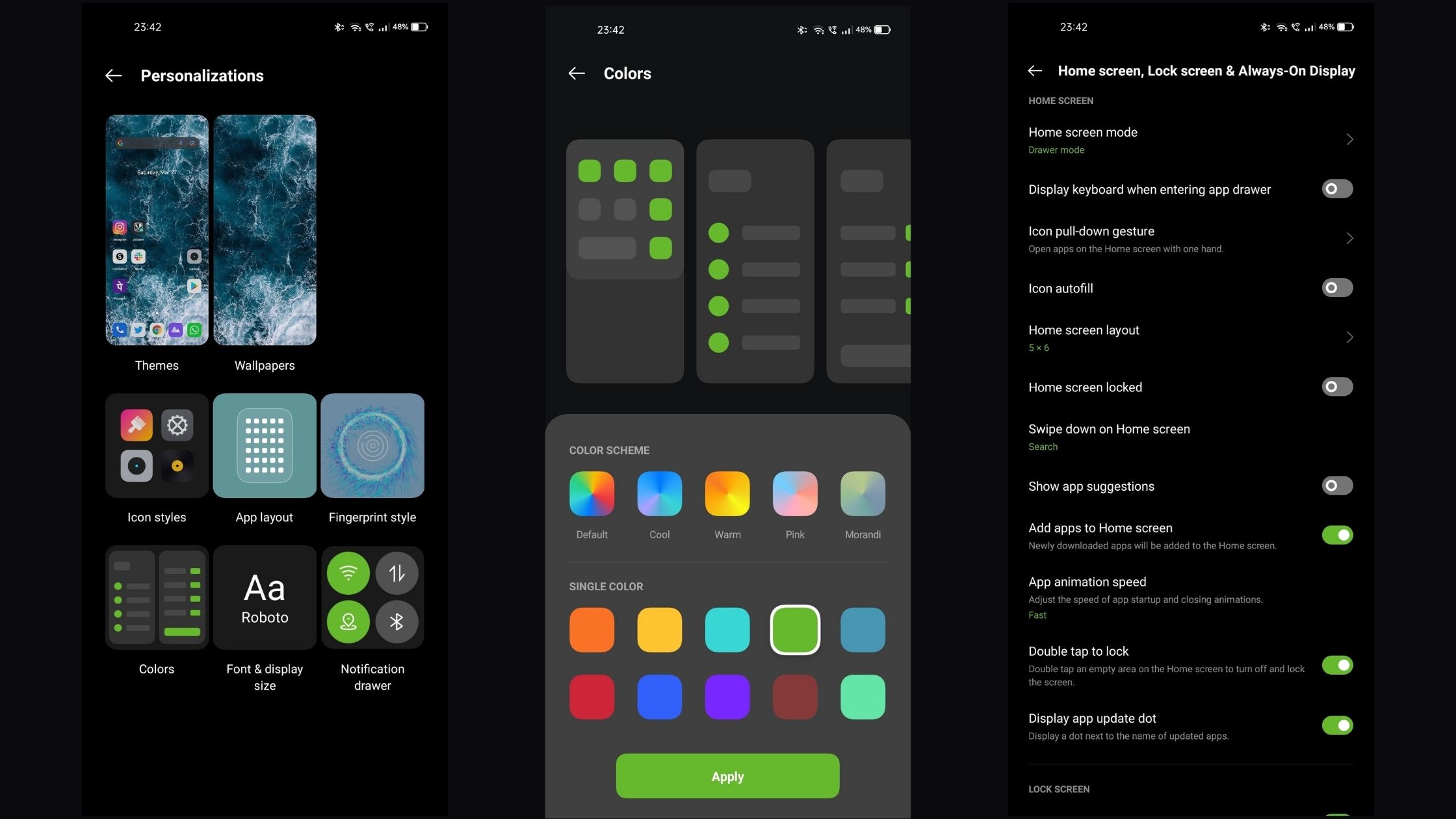
For easy multitasking, Realme has added a floating window and mini window support. Other features include Digital Health system, full gesture-based navigation, raise to wake, double-tap to wake/sleep, three-finger screenshot, auto pick calls, flip to mute, screen recording with internal audio, assistive ball, quick return bubble, smart slider, and more.
Overall, the Realme UI 2.0 has matured enough to run smoothly and the device has been optimized well on both the software and hardware front which results in an overall smooth software experience and also excellent battery life.
Cameras


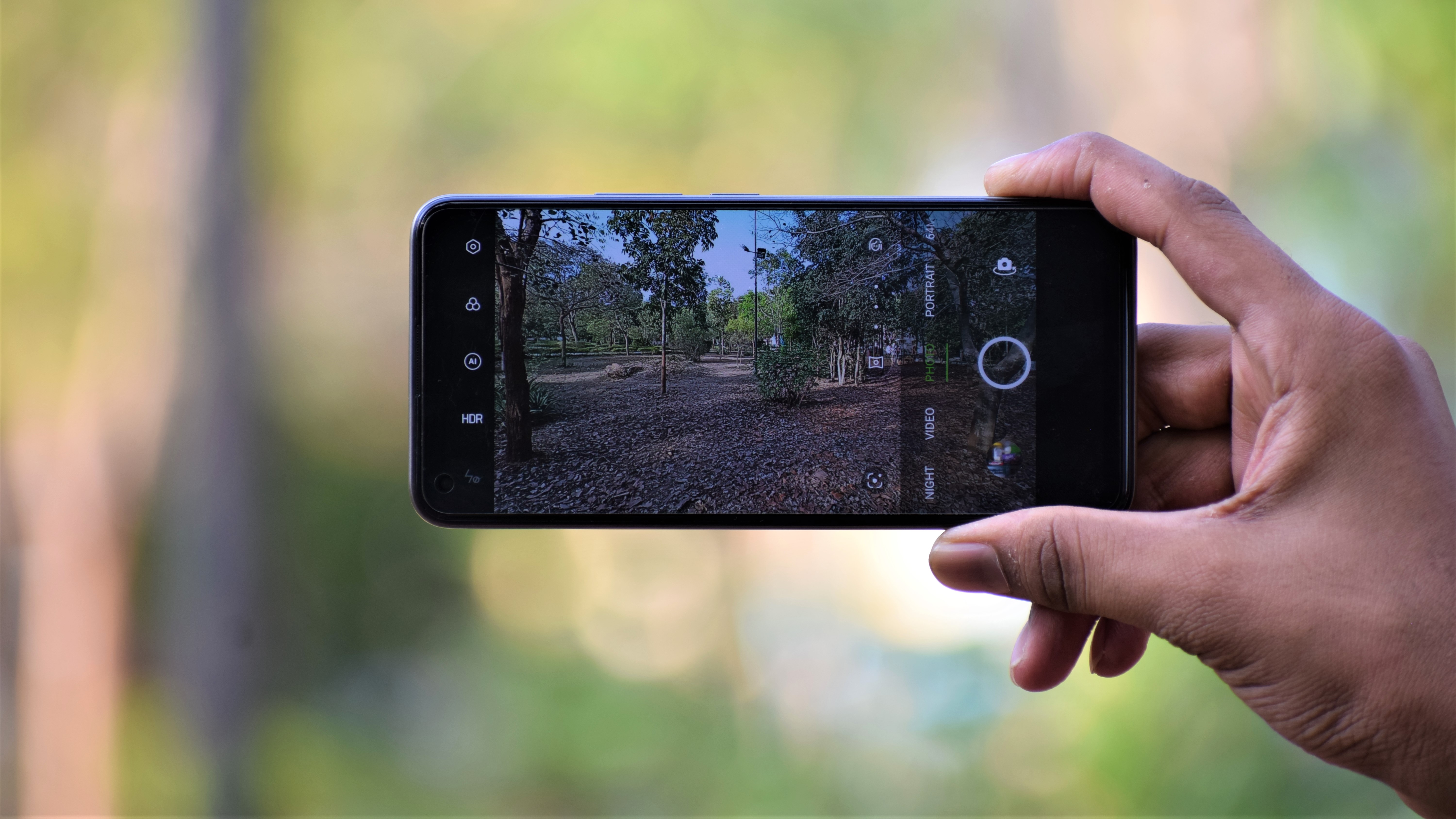
Realme is one of the early adopters of the quad camera and 64MP camera setup on budget phones. The Realme 8 has a 64MP f/1.79 main camera, an 8MP f/2.25 ultra-wide lens, a 2MP mono lens and a 2MP B&W lens - both with f/2.4 completing the quad-camera setup. On the front, the phone comes with a Sony IMX471 16MP punch-hole shooter. The primary 64MP sensor belongs to the Samsung OV series while on the Realme 7 we had a 64MP Sony IMX682 shooter.


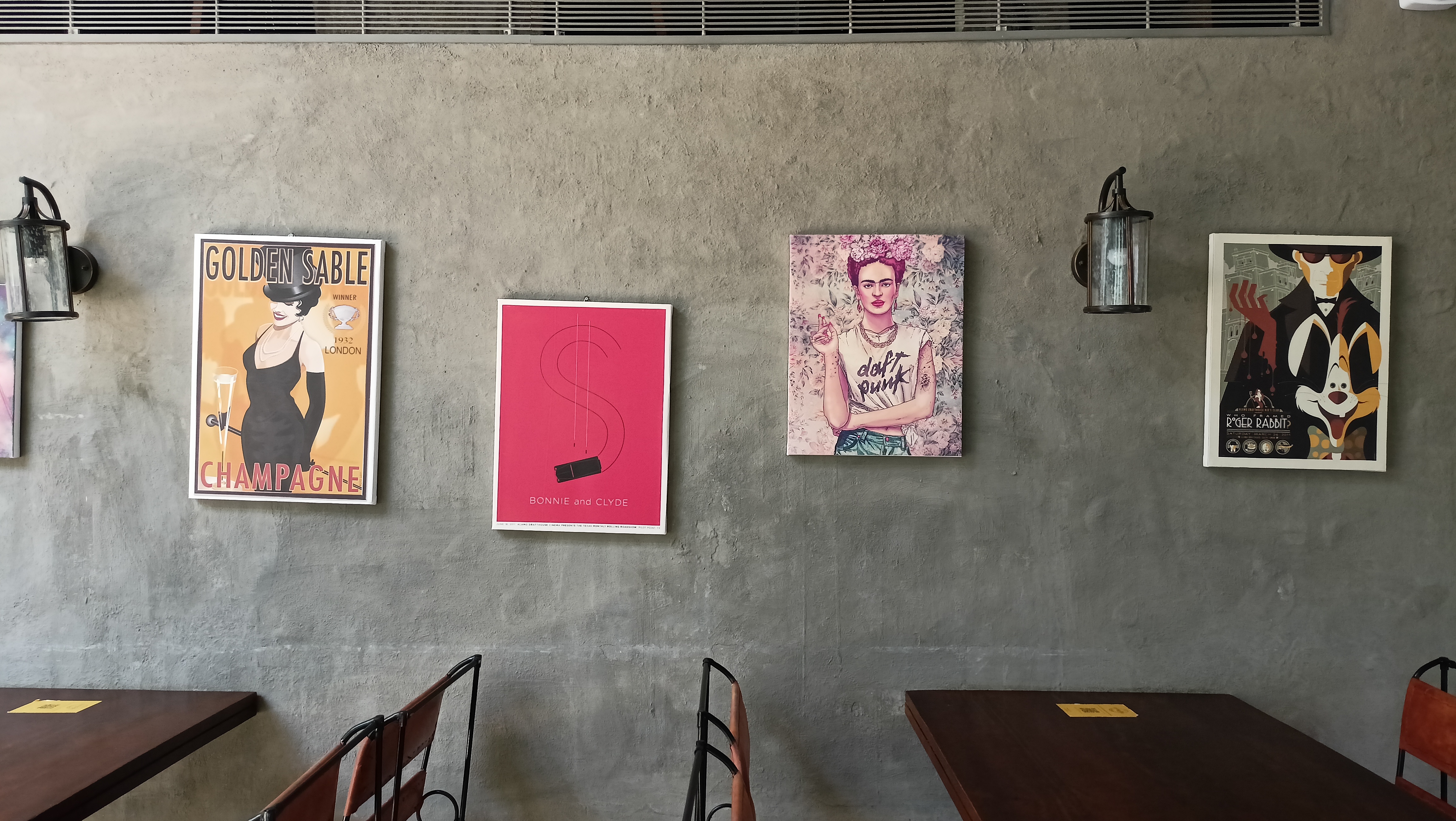






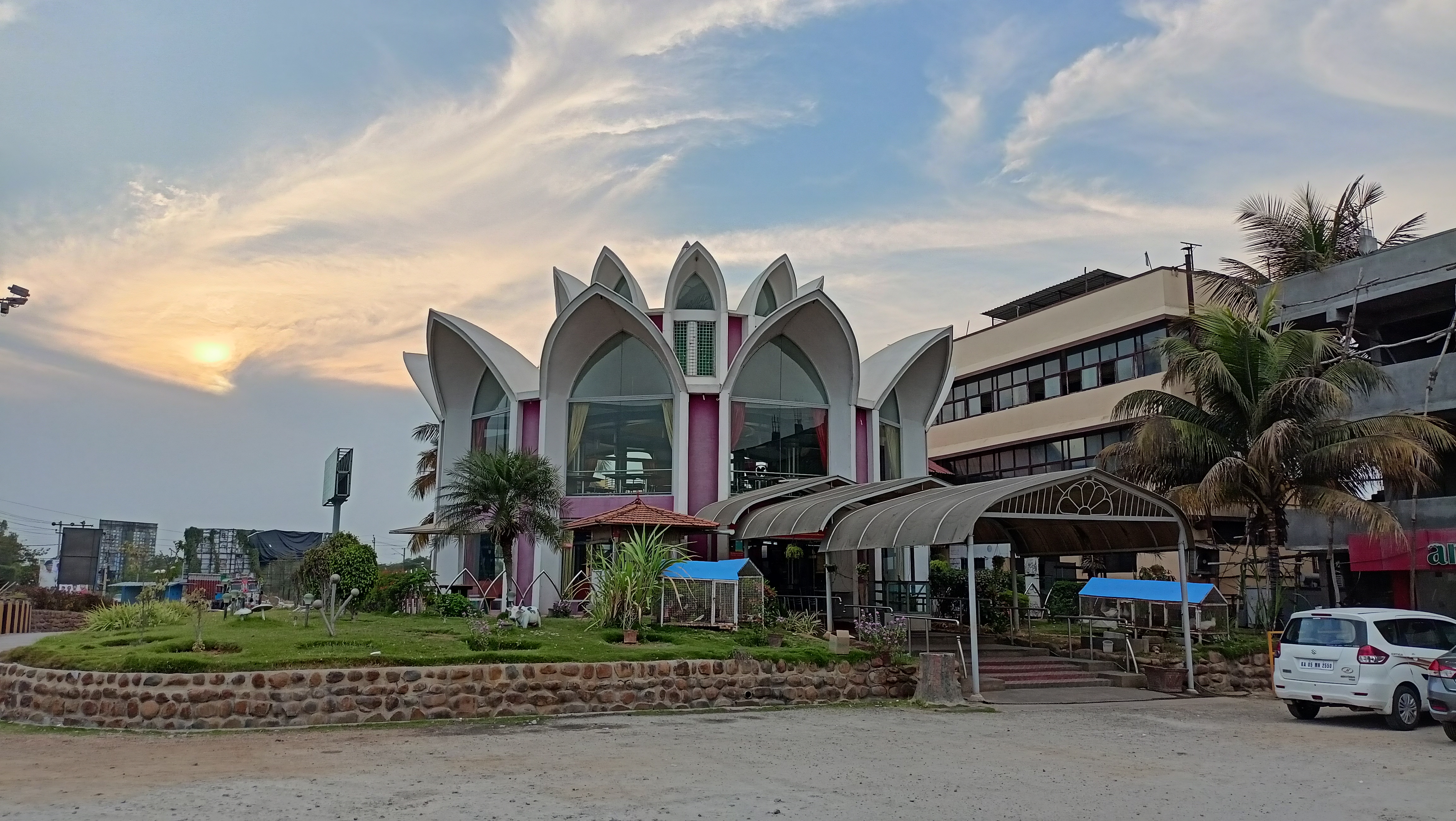








The images taken from the primary camera are by default clicked in 16MP, which produces great colours, dynamic range and details, but more often than not, the images tend to be over sharpened. The images come out bright, colour-popping and the Chroma Boost feature brings more life to the image, which most people like and are good to use on social media platforms. You get several AI modes, HDR, filters, Portrait, and 64MP mode. The 64MP images offer more details than usual when you crop in and zoom.
Other issues we noticed with the camera is that it brings more noise when shooting against the sunlight or direct lighting.
Portrait images camera out well though, with close to perfect edge detection in bright light scenarios.







The Night mode pictures are hit or miss on the phone. The Night mode improved exposure to bring more detail to the image, but it also invites more noise to the picture. The Night shots also need a bit more optimization and we hope an upcoming update will fix the issue.



The 8MP ultra-wide-angle camera produces a standard 119° field of view, the low-resolution sensor brings noise and also washes out colour while bringing down the contrast and also saturation. The ultra-wide is recommended only for casual use.


The macro camera is also pretty basic and produces sub-par images and there is the usual issue with focusing and also the quality.




The selfie takes good images in broad daylight, but make sure you turn off any filter or AI mode before clicking, as the selfies tend to come out with smooth tones. The selfies also can overexpose easily. The overall selfie camera experience is above-average and suitable for social media and video call usages, which is what most people use.
In a nutshell, the Realme 8’s camera performance is good, but it is let down by the secondary camera. The primary 64MP camera performs well, but there is still room for improvements. At the time of writing this review, we are told that a new camera update with Starry mode, tilt-shift and many more camera-related features, so we will update the section later if there’s any big impact on the camera performance.
But, for now, the Redmi Note 10 Pro Max is the best camera phone under Rs 20,000 while the Poco X3 is our second choice.
Battery

Even with losing almost 20 grams in weight and 1.5mm in thickness, the Realme 8 still manages to retain the big 5,000mAh battery that was also seen on the last-gen. The big battery is backed by a 30W charger in the box. Thanks to the chipset efficiency and smooth day to day operation, the battery life on the phone was incredible.
It’s hard to believe the phone this thin packs in a 5,000mAh battery
In our usage, the phone easily lasted two full days of usage with a mix of social media, work apps, games, and streaming. We got around 7 hours of screen on time consistently and up to 8 hours and 30 minutes. Even on a full day on mobile data, the battery life was similar.

On to the charging, we were pretty surprised by the speed at which the phone refuels. The Realme 8 takes just an hour to charge from 0 to 100%, sometimes even a few minutes faster. With 30 minutes of charge, the phone charges 60%.
Realme 8 aces with both in the battery life and fast charging here. It is even better when compared to the Redmi Note 10 series battery life and fast charging.
Biometrics
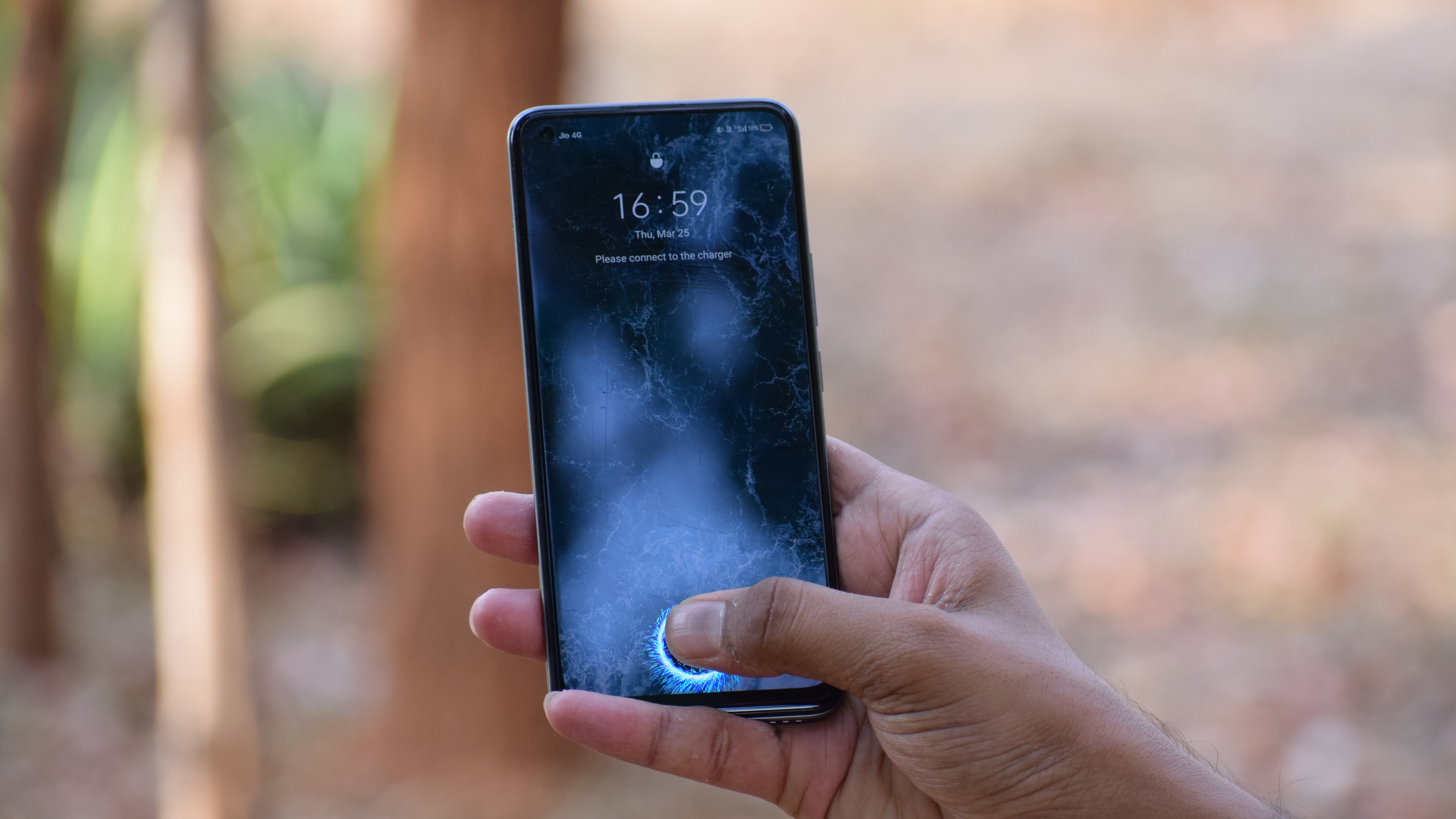
The Realme 8 is the first phone under Rs 15,000 to bring the in-display fingerprint scanner - a neat addition that adds a premium touch to the device. The in-display fingerprint scanner works very well, it is an active scanner and is very responsive. Additionally, you also get face to unlock which is blazing fast on the phone. Most of the time when you pick the phone to unlock with the fingerprint scanner, the phone is already unlocked with face recognition.
The fingerprint scanner can be used to lock apps and for private safe to store files as well.
Should I buy the Realme 8?

Buy it if...
You want reliable battery life
Even with its sleek design, the Realme 8 packs in a 5,000mAh battery that can easily last for two days. The excellent battery life is backed up by a 30W fast charger which can fuel up the device in an hour.
You want a sleek phone
While there is not much improvement in terms of specs from Realme 7, the Realme 8 manages to bring both weight and thickness under 180 grams and 8mm respectively - making it the lightest phone with a 5,000mAh battery.
You hate to wait for flash sales
The Realme 8 is available on open sale from day one on Flipkart. If you hate waiting for weekly flash sales, the Realme 8 is available easily 24/7.


Don't buy it if...
You want a high refresh rate
While the display is not particularly bad on the Realme 8, it misses out on the high refresh rate train. If that’s your priority, the Redmi Note 10 Pro, Pro Max, Moto G30, and Samsung Galaxy M12 might be your options in the budget segment.
You want the best phone in the segment
The Redmi Note 10 Pro and Note 10 Pro Max phones are still our top recommendation in the sub Rs 20,000 segment as they bring in an overall better value for money proposition.
- Realme 8 Pro review
- Best phones under Rs 15,000 | Best phone under Rs 20,000
- Upcoming phones in India
Follow TechRadar India on Twitter, Facebook and Instagram!
First reviewed: March 2021
via Tech Trade

Comments
Post a Comment